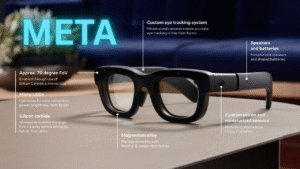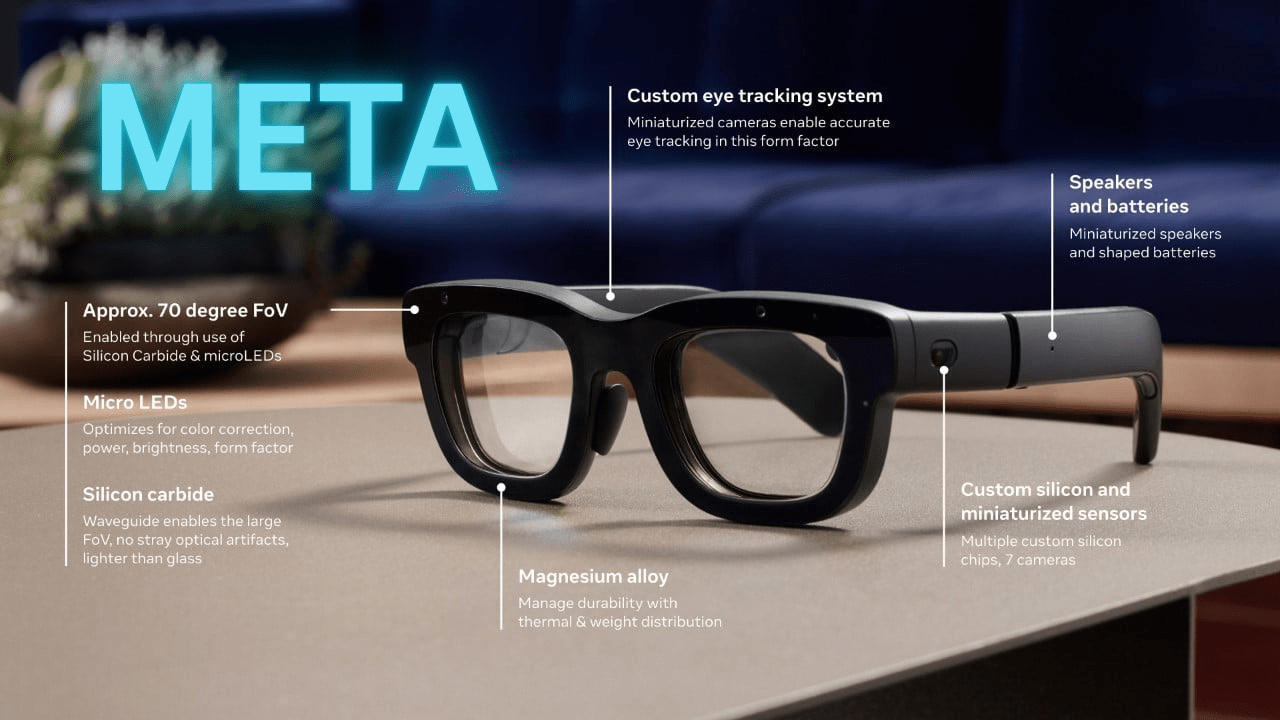Next-Gen Wearables: Holographic AR Glasses Explained
What Are Holographic Augmented Reality Glasses?
Holographic Augmented Reality (AR) glasses are head-mounted displays (HMDs) which superimpose three-dimensional (3D) digital images onto real-world scenarios viewed by users enhancing reality. Unlike the earlier versions of AR glasses, which used to project only flat images, holographic AR glasses project Volumetric images which are interpreted three-dimensionally and interacted with. The above technology makes use of Optics, AI, and sensors to provide contextual information which is seamlessly integrated into the user’s view.
By 2025, businesses like Meta and Apple are leading in the development of these devices. For example, Meta’s Orion glasses enable users to place both 2D and 3D content throughout their environment, as they can be viewed using spatial context. Apple is also furthering work on its smart glasses, putting focus on AR capabilities by designing chips tailored for multiple cameras.
Cross-Industry Real-World Use Cases

Healthcare
In the healthcare sector, AR hologram glasses are changing surgery and diagnostic imaging. Surgeons can interact with complex 3D anatomical models during surgeries, which increases accuracy and reduces risk. The ethical issues of technology concerning who has access to care when the price of implementation is a barrier, need to be considered.
Manufacturing and Engineering
Holographic AR glasses are being used by manufacturers to optimize processes on assembly line and maintenance. Through the use of wearable technology, technicians are provided with real-time hands-free digital overlays on machines, greatly improving operational workflow and effectiveness. The integration of real-time virtual data into the tangible workspace impacts productivity and safety in a positive way.
Education and Training
Educational organizations are using holographic AR glasses for immersive learning based on the coming of age technologies. With these glasses, students can interact with 3D models of historical artifacts, biological entities, or even intricate machines which enhances understanding and engagement. These glasses also provide simulations for skill development during vocational training without the associated risks of real-world practice.
Retail and E-Commerce
Using holographic AR glasses, retailers are enhancing the shopping experience like never before. Customers can now interact with products through virtual fitting. For instance, furniture can be positioned in the user’s room before buying. It can also be used for tailored recommendations as well as interactive displays bridging the gap between online shopping and physical retail stores.
Benefits of Holographic AR Glasses
Work related tasks often require referencing manual procedures which using these glasses in hands free guides to real-time information stream reduces. This leads to an Enhanced Productivity, focusing on critical tasks rather than information referencing.
In fields such as surgery and manufacturing, accuracy is of pinnacle importance. Activities supported by holographic projections are much more accurate in these areas and therefore have better results due to inaccuracy minimization.
Using interactive 3D content to explain concepts makes learning fun. It cuts across the boundaries of age or grades which enables teachers to reach each child’s potential making it easier for them to grasp and remember the material. This is known as Immersive Learning.
Transforming the retail sector with 3D product showcases along with tailored client interaction improves customer satisfaction hence making them more inclined toward making purchase leading to increased sales as well. This change has also transformed the Customer Engagement.

Risks and Ethical Considerations
Enhanced privacy capability through information recording poses serious surveillance concerns. Information can be captured without consent which endangers privacy of users and bystanders.
Costly development and purchasing of devices worsens the digital divide which restricts access. Equitable access should be ensured to prevent disparities resulting from technology.
Excessive consumption of AR glasses may result in eye strain, putting one’s health at risk. Further research is needed in this field toimagine health risks associated with these emerging technologies.
Holographic AR Glasses Technology
Improvements in optics and AI are expected to increase the affordability and practicality of these technologies in the near future. The aggressive R&D spending of industry leaders such as Meta and Apple shows their readiness in making these products available to consumers.
Widespread utilization in entertainment, real estate, public services, and other industries can be expected as the technology becomes more mature. While it will be crucial that ethical limits beyond stustainabilitechnologrequest lo met social equality objects are fully addressed.
Expert Perspective
As reported by The Verge, Mark Zuckerberg, Meta’s CEO, predicts that AR glasses will become a fundamental computing platform, surpassing smartphones in the next 10 years. He foresees the merging of AI and smart glasses as a critical factor of this advancement.

Final Takeaway
Holographic augmented reality glasses are transforming industries by integrating the digital and physical worlds. Their use in healthcare, manufacturing, education, and retail demonstrates their ability to improve and redefine workflows. Although there are issues to be resolved, the development and ongoing ethical debates surrounding this technology will continuously refine it.
Learn how holographic augmented reality glasses can propel your business into the future.
Internal Links:
/augmented-reality-healthcare/wearable-technologies-decade



















Post Comment